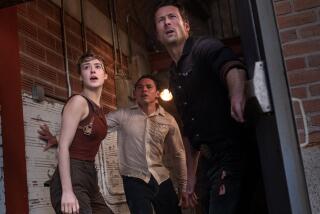Docking Soon: Titanic-Mania
- Share via
The loss of innocence and elegance. The dawn of cynicism. The first great failure of the Industrial Age. The beginning of the end.
When the luxury ocean liner Titanic sank April 15, 1912, on its maiden voyage, after hitting an iceberg in the North Atlantic, the vessel’s story quickly became more than just that of a shipwreck.
The “unsinkable” marvel of design that had boasted such luxurious amenities as Turkish baths and the finest china and crystal in its dining room did not have enough lifeboats for its passengers. More than 1,500 of the 2,228 people aboard went down with the ship, and among the deceased were such rich and powerful men of the day as John Jacob Astor, Isidore Strauss and Benjamin Guggenheim.
The Titanic’s fate was rife with so many great themes--life and death, class and wealth, humanity versus nature--that it was quickly transformed from a major news story into a nearly mythic event.
And though the ship has rested at the bottom of the sea for nearly 85 years, its story is still being told. In fact, a new round of Titanic-mania seems to be upon us.
Sunday night, TV viewers can see Part 1 of “Titanic,” a two-part, four-hour movie on CBS starring George C. Scott, Peter Gallagher, Tim Curry and Marilu Henner. Coming in the spring is “Titanic” the Broadway musical, and the summer of ’97 will bring a “Titanic” feature film, written and directed by James Cameron.
None of the creative teams behind these projects was aware of the others when they began developing them. But there may be some powerful reasons why interest in the Titanic has suddenly peaked.
“I think the 85th anniversary is part of it,” says author Steven Biel, who analyzes the Titanic as pop phenomenon in the recently published “Down With the Old Canoe.” “But there’s also this end-of-the-century aspect. There’s a desire to find a defining moment of the 20th century. In a lot of ways it’s been a pretty disastrous century--World War I, World War II, the Holocaust, the Nuclear Age and any number of genocides. You can’t point to the Titanic as a disaster greater than those, but if you want to look back and ask, ‘When did things start to go wrong?,’ the Titanic is a very powerful symbol.”
For Robert Lieberman, the director of the CBS movie, the Titanic came to symbolize a marker between two distinct eras.
“What drew me to this project more than anything was the period--a truly remarkable time,” he says. “A huge percentage of all the patents up to that time were filed in the 10 to 15 years before the Titanic. The combustion engine, Edison’s inventions, the Marconi radio. There was invention, elegance and such great hope. And I think all that hope sank with the Titanic. We passed from the age of optimism to the age of pessimism.”
The tale of the Titanic has been retold dozens of times through the years. By the end of 1912 a first film had been made--”Saved From the Titanic.” The 1953 film “Titanic” starred Barbara Stanwyck and Clifton Webb, and Walter Lord’s 1955 bestseller “A Night to Remember” was made into a film in 1958.
Current fascination with the ship was stoked in 1985, when the ship’s wreckage was discovered on the ocean floor. And some of the same leaps in technology that allowed for exploration of the wreck have made the current Titanic projects possible--both the TV and feature films will make extensive use of computerized imagery to re-create the sinking of the ship.
Producer Frank Konigsberg is proud of the look his $13-million miniseries was able to achieve but says he was more concerned with the story’s human element rather than its potential for spectacle.
“We tried to dramatize it in a ‘You Are There’ way,” he says. “I think that’s one of the powerful attractions of the story--everybody wonders what they would do on a slowly sinking ship. Would you be brave and noble and help other people? Would you do anything to save yourself? Would you go to the bar in your elegant clothes and quietly sip a final cognac? You’re in the midst of this luxury, but you’re sinking into icy waters. You have just enough time to think about what’s happening and how you want to spend your final moments. It’s a remarkable situation to imagine.”
It may seem difficult to imagine the tragic tale of the Titanic in musical form, but Peter Stone, who wrote the book and story for the Broadway production, believes the ship’s story will make a compelling work of theater.
“The story’s irresistible, frankly,” he says, “which is why so much is going on. You can’t make up a list of the 10 most important events of this century without mentioning the Titanic. Man had come to believe he could rival nature, and of course he couldn’t. This was bound to happen, and the fact that it happened on a maiden voyage is more than any dramatist could ask for.”
Stone’s Broadway credits include “Woman of the Year” and “The Will Rogers Follies,” and for “Titanic” he is teamed with composer and lyricist Maury Yeston (“Nine”). The production is in final casting and will be in rehearsals by the end of the year. It is likely to open very close to the 85th anniversary in April.
Stone has had previous success with equally improbable musical material--he won a Tony for turning the American Revolution into “1776.”
“When I did that show, people said, ‘How can an audience enjoy a story if they already know what happened?’ But suspension of disbelief is one of the strongest principles of theater. And though the Titanic was a tragedy, the story isn’t without fun--before the ship hit the iceberg, the people aboard were having the time of their lives. Afterwards, it’s about who survives, who doesn’t and why. We certainly don’t want to trivialize these human stories on stage--we’re attempting to memorialize them.”
James Cameron has been a successful pioneer of digital technology in films such as “Terminator 2” and “True Lies,” and will again ride the cutting edge in bringing “Titanic” to the big screen. But executive producer Rae Sanchini says it’s been important to the film’s creative team to render the human stories as convincingly as the digital icebergs.
“I think there’s a strange feeling that this had to happen, that somehow everyone who got on that ship was ready to perish,” she says. “You look at an old photograph of the crew standing stiffly together, and the tendency is to see Titanic victims rather than young men, bursting with life, who thought they had great futures ahead of them. The time and the tragedy feel distant, but it wasn’t really that long ago. It was important to us to go back and look at the people on this ship as very real people.”
Cameron’s film, which has been shooting off the Baja Mexico coast near Rosarito Beach, will be the first work of fiction to give a part to the actual wreck of the Titanic: He went to the bottom of the sea himself and filmed the ship in September 1995. The ship was also in the news this past summer, when a salvage operation unsuccessfully attempted to bring a piece of hull to the surface.
For all the fictional Titanics about to set sail, director Lieberman hopes that the real ship will be allowed its peace in the briny deep. “It refuses to come up, as well it should. What’s the point? We can tell the story now without having to disturb it. Let it rest.”
* “Titanic” airs 9-11 p.m. Sunday and Tuesday on CBS (Channel 2).
More to Read
Sign up for The Wild
We’ll help you find the best places to hike, bike and run, as well as the perfect silent spots for meditation and yoga.
You may occasionally receive promotional content from the Los Angeles Times.






